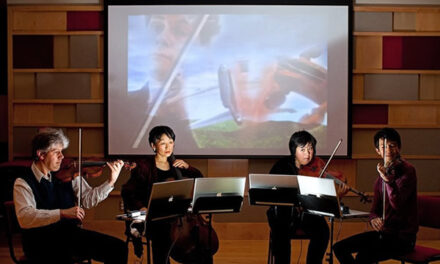The Raleigh Ringers continue to astonish as they demonstrate the exciting versatility of handbells in the hands of sixteen dedicated and virtuoso players. They began the twentieth year of their existence before a great crowd of enthusiastic fans at Meymandi Concert Hall on a warm and lazy Sunday afternoon. This June concert series, all under Music Director David M. Harris, will see them on to three more appearances in Ohio and Pennsylvania.
The objectives of the group seem to consist of equal parts entertainment, handbell education, and the vigorous promotion of handbell literature. Indeed, twelve of the fifteen selections on the concert program were written or arranged for The Raleigh Ringers. The collection of bells arrayed on the stage constitutes quite a show in its own right. The program booklet referred to “…seven and one-half octaves of Malmark handbells, five octaves of Whitechapel handbells, three and a half octaves of Petit & Fritzen…” and so forth on up to a total of some 350 instruments. And if they run short, “Additional handbell needs are supplied by Schulmerich Carillons.”
The program could scarcely have been more musically diverse. At one end of the spectrum was “Faith,” arranged by Paul McKlveen. Played on the “Whitechapel” bells, this piece was of so solemn and peaceful a nature that it would fit pleasingly into any liturgical setting. (The challenge would be to find a church group equal to its demands.) “Let All Mortal Flesh Keep Silence,” arranged by Cathy A. Moklebust, presented a set of stylized variations on that familiar theme.
William A. Payn (the group’s Artistic Consultant from Bucknell University) has adapted a symphonic piece for bells. Called “Yearning,” it preserved the symphonic sound and maintained the drive and power that one associates with such music. (Harris pointed out that it called for 192 bells, whereas most pieces use about half that many.) Another stunning offering was “Csárdás,” a Hungarian folk tune arranged by Toshikazu Yoshida. The familiar melodies were treated with all the delicacy and courtesies characteristic of a proper Japanese tearoom.
Then there were such worthies as “Yakety Sax,” Kryn Krautheim’s arrangement of the Benny Hill theme (with industrial-strength clowning in the low bells), and “Barnum and Bailey’s Favorite,” showing the considerable range of musical tastes evinced by Cathy Moklebust, an arranger referenced above.
Many other numbers from the extensive program could have been adduced as representative of the group’s talents. The festive and animated fans evidently considered themselves well served. (By one measure the balcony patrons were not served quite so well. The colored spotlights that provided the “mood” lighting for the backdrop screen were distractingly intrusive. Perhaps a bit of rearrangement would be in order.)












